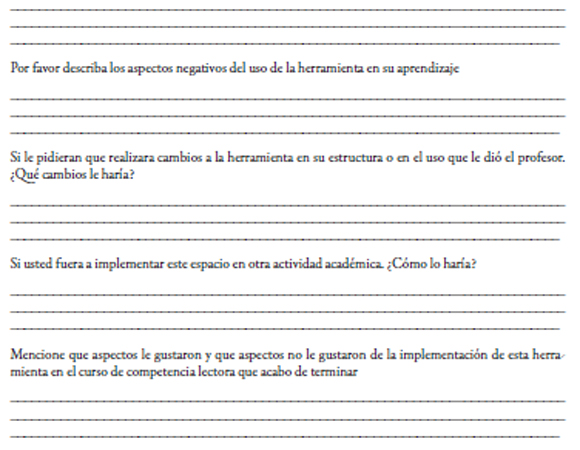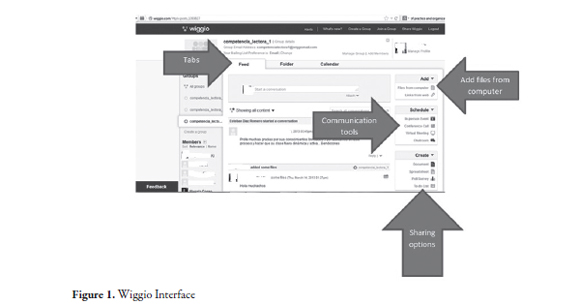
Wiggio has other sections. On the left-hand side users can access the groups; they have registered or created and can create a new group. Once the group has been selected, users can view the members of that group in particular. On the right-hand side users view other four sections: add, schedule, create and send. Users can add files from a computer or can add links to other sites from the add section. Users can schedule an in-person event, a conference call, a virtual meeting or a chatroom from the schedule section. Users can create documents, spreadsheets, surveys or polls and to-do lists from the create section, and finally users can send requests, text messages, e-mails, voice and video notes to the group or to specific members of a group.
Every time there is a new post or a new file is created or uploaded, Wiggio sends a message to the participant`s mail address. Participants can respond directly to the Wiggio feed or to the e-mail notification address.
The Study
The general framework of this study is the view of teachers as researchers (Freeman, 1998). This study is a single instrumental case study with a holistic and interpretative approach to data analysis. It is single instrumental because it focuses on a specific issue, it uses a holistic and interpretative approach to analyze the data because the entire case is examined and descriptions, themes and interpretations or assertion related to the case are present. I followed a case study because it allows me to explore a case over time through data collection involving multiple sources of information. (Creswell 2007; Merriam 1998; Stake 1995; Yin 2003)
Methodology
Data collection instruments and analysis.
Three instruments were used in this study: (1) an online questionnaire, (2) the reflections from the teacher’s diary, and (3) the interaction and conversation on the web-based environment in order to have saturation of data and to have triangulation of information. (Cresswell, 2007; Yin, 2003).
The online questionnaire.
The questionnaire was based on a similar questionnaire used by Elmaziye and Birikim (2009) in a study that sought to develop a comprehensive insight into the perception of students regarding the use of an interactive web environment in an English course. The questionnaire has two main sections that aim at identifying the advantages and disadvantages of the implementation of the web-based environment. The advantages section has 6 questions and the disadvantages section has 12 questions. The questionnaire was written in Spanish to ensure the respondents understand the questions. Most of the questions were structured questions that required students to answer using a Likert Type Scale. Using this scale, respondents could strongly agree, strongly disagree or express uncertainty concerning the given statement. The questionnaire was uploaded into a Google form and then it was embedded into the web-based environment. It was available during 3 weeks for the students to respond. The questionnaire also included information relevant to the study. For example, who was the person responsible for the activity, and the contact information as well as the purpose of the activity; the length and the technological resources employed, and the benefits and the implications for the participants. The questionnaire also included a consent form that was accepted by clicking on an I-accept button. The appendix shows the complete questionnaire.
Teacher’s diary.
The teacher kept a three-column journal in order to record his observations, reflections and perceptions of the implementation of the web-based environment (Jeffrey & Hadley, 2002). On the first column, the teacher wrote the number of the entries and the date when they were written. On the next column, the teacher wrote a detailed description of the class and how he used the web-environment, for example to send a message, to send a file or to schedule an event. Finally, on the last column, the teacher wrote the effects of the web environment on the development of the class. Table 1 shows the format used to collect and analyze the reflections from the teacher’s diary.
Interaction in the web-based environment. The interactions or conversation on the webbased
environment were collected using a four
column format. The first column is filled with
the date on which the conversation was posted.
The second column includes the name of the person
who initiates the conversation. On the third
column the content or the subject of the conversation
is identified, and the last column is to be used
in case the post has an attached file. Table 2 shows
the chart used to analyze the interactions or conversations
within the web-based environment. Participants. The participants in this study were undergraduate
microbiology students registered in an English reading comprehension course and their professor.
The group consisted of 24 females and
10 males between the ages of 17 and 25. During
the course 6 women and 3 men dropped out for
different reasons, therefore 25 students satisfactorily
completed the course requirements. The author of this article was the instructor of the
course. He has more than 20 years of experience
teaching English in traditional settings. He has
had some training in the inclusion of technology
into the classroom, but mostly he based his performance
on his personal experience and enthusiasm
of ICT and their pedagogical inclusion. Findings On this section of the paper, the effects of the
implementation of a web-based environment in a
face-to-face class will be presented. The implementation
of a web-based environment in a face-to-face
class can be viewed from 5 different managerial
areas: (1) Logistics management, (2) information/
knowledge management, (3) communication management,
(4) class work extension management,
and (5) easiness of accessibility management. Logistics management. Sanz (2005) states that a web-based environment
allows the participants keep up with the dynamics
of the group. The web-based environment can
be used to remind participants about aspects of the
course as assignments, time and place of the class, changes in the course dynamics and as a medium
to praise the performance of the students. This
area of management is evident in this entry from
the teacher`s journal in which he expresses that he
could use the web-based environment to ask students
to bring an assignment or an article to class. Another logistic aspect of the course in which
the web-based environment was used was to provide
feedback to students. 71% of the respondents
agreed when they were asked if they had feedback
from the teacher outside of class hours. Information / knowledge management. The web-based environment was widely used as
a material repository. Pineda & Tobón (2011)
identify several benefits of using a web-based
environment, a blog in their case, in a face-to-face course. They state that the use of a web-based
environment allows students to have access to
the materials used in previous classes, and it
also increases the students’ level of motivation.
Figure 2 shows the way the teacher used the webbased
environment as a repository of material.
The teacher sends a series of files with the work
for an upcoming class. This area of managerial area of the course is evident
in this post from the course instructor. The instructor of the course also reflected on the
use of the web-based environment to manage
information and knowledge. Students also perceived that the web-based
environment can be used as an information/
knowledge management strategy. This is evident
in the answers to these questions. 98% of respondents
totally agree when they were asked if they
could ask questions to the teacher outside of class
hours and 64% totally agreed when they were
asked if they used the web-based environment to
discuss class topic with their classmates. Communication management. Swan (2001) as cited by Lopera & Osorno
(2012) argues that communication in a webbased
environment follows the same patterns as
in a face-to-face class. Asking for help, questions
about a specific exercise, and waiting for advice.
The communication in the web-based environment
took place between the instructor and the
students, but also among students when sometimes
a question asked by a student was answered
by another one. Evidence of this is the series of
posts from student where they report a story they
had to read. Figure 3 shows a discussion between
two students who selected the same reading for a
class activity and a final post from the teacher presenting
a list of the selected readings. Student 1
Hello my story is the new religion Student 2
I’m sorry, but I’ve seen the list and I’ve chosen that story Student 1
Yes, you’re right. What happened is that nobody could
see my post. Student 2
It’s ok, I’ll look for another one The communication also took place between
teachers and students. Evidence of this is the series
of posts in which a student excuses for a missing
class and asks about the assignments as presented
in figure 4. Class work extension management. Teaching cannot be restricted only to the classroom;
teachers and institutions need to open
their boundaries to make learning a daily experience.
The use of a web-based environment allows
students to explore the topic studied in class anytime
and anywhere (Pineda & Tobón, 2011). This
is shown from the teacher´s post below.
Students also perceived as positive the use of the
web-based environment to extend the work outside
the classroom as it is evident in this response
when the students were asked about the reasons why
they would recommend the use of this web environment
as an academic support to a face-to-face course. Student Easiness of accessibility management. A user friendly interface is considered as one of
the factors that facilitates the implementation of
a web-based environment in a face-to-face classroom
as stated by Florez, Pineda & Garcia (2012).
The general perception of students of the webbased
environment was very positive. They did not
report much trouble accessing the environment
or understanding the activities and the messages
posted. 86% of the respondents of the questionnaire
reported to have a computer at home from
which they access the web-based environment,
and 93% reported a fast internet connection at
home. Only 50% of students reported to have had
some problem because the interface of the site was
in English. Interestingly, there is a slight difference
between the participants who reported to have a
printer at home and the ones reporting they do
not have one: 43% and 50% respectively. Finally,
an outstanding 57% of the participants said they
waited to go to class to copy the papers for the
class work although they viewed the assignments
from their computers at home. They highlighted
that this was because it was cheaper to make a photocopy of a page than to print it. When asked
to elicit the problems they had during the implementation
of the web-based environment, the
students did not report any. Evidence of this is the
response from a student. Conclusions, Implications
and Limitations This study presents the effects of the implementation
of a web-based environment in a
face-to-face course. I explored the effects from
5 different managerial areas: (1) logistics management,
(2) information and knowledge
management, (3) communication management,
(4) classwork extension and (5) easiness of accessibility
management. Teachers can implement a web-based environment
in a face-to-face course to manage aspects
such as assignments, changes in times and places
where the class would take place, changes in class
dynamics such as cancellation of tests or exams or
unplanned guests speakers. Teachers can also use
the web-based environment to praise students
of their work or to call students’ attention about
inappropriate behavior. By implementing a web-based environment in a
face-to-face class, teachers can also manage information
or knowledge by using the environment as
a repository of materials that students can access
from anywhere at any time. Students can also
access the information from lessons they cannot
attend or they can access information about the
topics they found difficult. Teachers, similarly,
can use the web-based environment to send extra
information about difficult topics. Communication management was another
finding from this study. Teachers can use the webbased
environment to answer questions about
specific exercises, class work or to give specific
advice about the performance of some students. Students could send questions and reports about
activities carried out outside the class hours. The web-based environment was used to open
the boundaries of the classroom by providing the
students the opportunity to study the class topic
at any time. Teachers can use the environment to
assign extra work, to send relevant information
about a topic, to provide students with tools that
can be used outside the classroom. The web-based
environment can be used as academic support for
the face-to-face class. When implementing a web-based environment, it
is necessary to consider topics such as the access
the students would have to computers at home or
provided by the institution, the access to internet
available to students, and the access they have to a
printer since they have to take some physical tools
to the classroom such as workshops, readings, and
questionnaires. The study presents four main limitations. First, the
lack of an orientation session or period to explain
how the web-based environment works. This
orientation session would have helped students get
familiar with the system. This orientation session
can be either face-to-face or a video tutorial can be
feasible. Second, the lack of support to students
to solve technical problems. Although only some
students reported technical problems, it was very
difficult to provide them with the right assistance
because there was not a strategy designed with
that purpose. Third, the web-based environment
was only implemented in one group which makes
it very difficult to get to generalizations of the
findings. And finally, the size of the group in which
the web-based environment was implemented
and the number of times of the implementation.
The group had only 25 students and the web-based
environment was implemented only once which
makes generalization difficult to achieve. References Brown, S. (2012). Seeing web 2.0 in context: A study of
academic perceptions. Internet and higher education.
15. 50-57. Bennett, S., Bishop, A., Dalgarno, B., Waycott, J. & Kennedy,
G., (2012). Implementing web 2.0 technologies in
higher education: a collective case study. Computers
and Education, 59, 524-534. Creswell, J. (2007). Qualitative inquiry and research design:
Choosing among five approaches (2nd ed.). Thousand
Oaks, CA: Sage Publications. Dwyer, C., Hiltz, S., & Passerini, K. (2007). Trust and
privacy concern within social networking sites: A
comparison of Facebook and Myspace. In Proceedings
of the thirteenth americas conference on information
systems. Keystone, Colorado. Elmaziye, O. & Birikim, O. (2009). Web 2.0 in learning
English: the student perspective. Procedia-Social
and behavioral sciences, 1(1), 326-330. Freeman, D. (1998). Doing teacher research: From inquiry to
understanding. Boston, MA:Newbury House. Florez, E., Pineda, J. & Garcia, N (2012). EFL students’
perceptions about a web-based English reading
comprehension course. PROFILE Issues in Teachers’
Professional Development, 14(2), 113-129. Gonzalez, A & Muñoz, J. (2011). Teaching reading
comprehension in English in a distance web-based
course: New roles for teachers. PROFILE Issues in
Teachers’ Professional Development, 12(2), 69-85. Hemmi, A., Bayne, S., Land, R. (2009). The appropriation
and repurposing of social technologies in higher
education. Journal of Computer Assisted learning,
25(1), 19-30. Jeffrey, D., & Hadley, G. (2002). Balancing intuition with
insight: Reflective teaching through diary studies. The
language teach, 26(5). Retrieved from http://www.jaltpublications.org/tlt/articles/2002/05/jeffrey Kocak, U., & Guzin, S, (2009). Adoption of web 2.0 in
distance education. Procedia. Social and Behavioral
Sciences, 1, 818-823. Lopera, S. & Osorno, J. (2012). Interaction in an EFL
reading comprehension distance web-based course.
Ikala. Revista de Lenguaje y Cultura, 17(1), 45-59. Merriam, S. (1998). Qualitative research and case study
applications in education. San Francisco, CA:
Jossey-Bass. Pai, P., Arnot, C. (2013). User adoption of social networking
sites: eliciting uses and gratifications through
and end-means approach. Computers in Human
Behavior, 29, 1039-1053. Pineda, J & Tobón, M. (2011). The use of blogs as learning
platforms. ASOCOPI Newsletter, 3, 6-11. Sanz, S (2005). Comunidades de practica virtuales: Acceso y
uso de contenidos. Revista de Universidad y Sociedad
de Conocimiento, 2(2), 26-35. Salmon, G (2011). E-moderating. The key to teaching and learning online third edition. New York. Routledge. Salmon, G. (2002). E-tivities. The key to active online learning. London. Routledge. Salmon, G.(2013). E-tivities. The key to active online learning.
Second edition. New York. Routledge. Stake, R. (1995). The art of case study research. Thousand
Oaks, CA:Sage. Wenger, McDermott & Snyder (2002). Cultivating communities of practice: A guide to managing knowledge. Harvard Business School Press. Boston. USA. Yin, R. (2003). Case study research: Design and methods.
Thousand Oaks, CA: Sage Publications 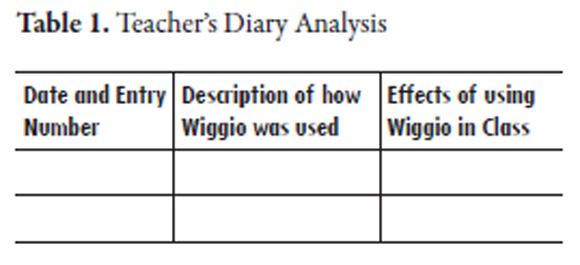
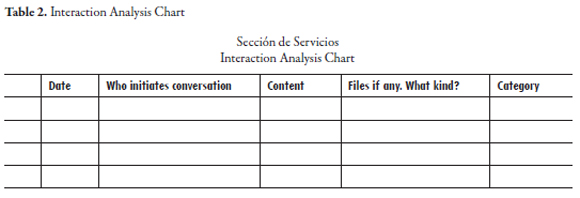
The implementation of the site allowed me to have a
constant communication with the students. They send
questions, reports and sometimes they even sent excuses
for missing classes. I also sent messages when I needed
them to bring something to class or when I needed to
correct or go deeper into a topic.

Hello everyone
Attached you’ll find the papers we’ll use in our class
on Tuesday. Remember that on Tuesday we’ll start
exploring our next topic and I think we’re doing fine
so far.
I think the implementation of Wiggio in this course
has had several positive aspects and surely it has had
several negative aspects that need revision for further
implementations. Among the positive aspects, I can say
that I found a repository for my course materials.
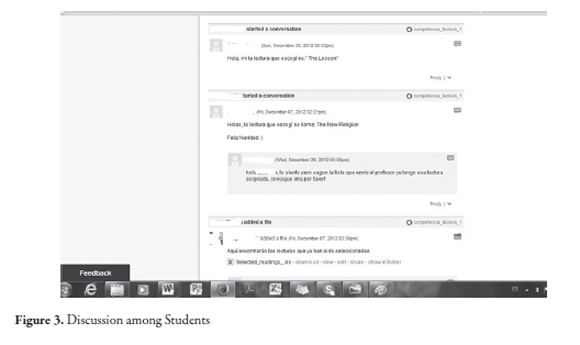
Hello everyone
As I’ve seen you’re having some problems with grammar.
I’ve done a search on the internet and I’ve found this
interesting site for you to practice. Click on the link and
choose the topic you want to practice
I didn’t experience any trouble. It is a very educational
and easy to use tool. Besides it is very cool.



